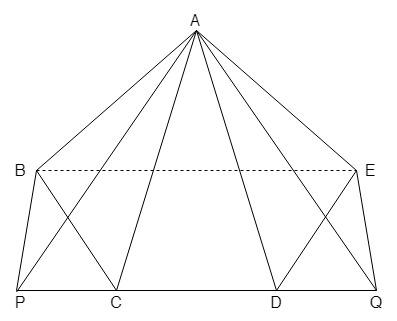
In Fig. ABCDE is any pentagon. BP drawn parallel to AC meets DC produced at P and EQ drawn parallel to AD meets CD produced at Q. Prove that ar (ABCDE) = ar (\[\Delta \]APQ).


Answer
557.7k+ views
Hint: According to the given question, we have to take two triangles that is \[\Delta ADQ\] , \[\Delta ADE\] and\[\Delta ACP\], \[\Delta ACB\] . Using these triangles we will prove that their areas are equal.
Complete step-by-step answer:
Given Points:
1.ABCDE is a pentagon
2.BP \[||\] AC
3.EQ \[||\] CD
We have to prove that ar (ABCDE) = ar (APO). Where ar stands for area.
So, let’s say that \[\Delta ADQ\] and \[\Delta ADE\] are at the same base that is AD and between the same parallel lines.
Therefore, we can say that their areas are equal, that is ar (\[\Delta \]ADQ) = ar (\[\Delta \]ADE). --Equation 1
So, let’s say that \[\Delta ACP\] and \[\Delta ACB\] are at the same base that is AC and between the same parallel lines.
Therefore, we can say that their areas are equal, that is ar (\[\Delta \]ACP) = ar (\[\Delta \]ACB). ---Equation 2
Using both the equations 1 and 2, by adding we get,
ar (\[\Delta \]ADQ) + ar (\[\Delta \]ACP) = ar (\[\Delta \]ADE) + ar (\[\Delta \]ACB)
As to make ar (\[\Delta \]APQ) on the left side and ar (ABCDE) on right side we must add ar (\[\Delta \]ACD) on both sides of the equation.
Hence, on adding we get,
ar (\[\Delta \]ADQ) + ar (\[\Delta \]ACP) + (\[\Delta \]ACD) = ar (\[\Delta \]ADE) + ar (\[\Delta \]ACB) + (\[\Delta \]ACD)
Therefore, ar (\[\Delta \]APQ) = ar (ABCDE)
Hence Proved
Note: To solve these types of questions, we need to proceed with the given points. Using the different properties of triangles we can calculate any type of requirement in the question.
Complete step-by-step answer:
Given Points:
1.ABCDE is a pentagon
2.BP \[||\] AC
3.EQ \[||\] CD
We have to prove that ar (ABCDE) = ar (APO). Where ar stands for area.
So, let’s say that \[\Delta ADQ\] and \[\Delta ADE\] are at the same base that is AD and between the same parallel lines.
Therefore, we can say that their areas are equal, that is ar (\[\Delta \]ADQ) = ar (\[\Delta \]ADE). --Equation 1
So, let’s say that \[\Delta ACP\] and \[\Delta ACB\] are at the same base that is AC and between the same parallel lines.
Therefore, we can say that their areas are equal, that is ar (\[\Delta \]ACP) = ar (\[\Delta \]ACB). ---Equation 2
Using both the equations 1 and 2, by adding we get,
ar (\[\Delta \]ADQ) + ar (\[\Delta \]ACP) = ar (\[\Delta \]ADE) + ar (\[\Delta \]ACB)
As to make ar (\[\Delta \]APQ) on the left side and ar (ABCDE) on right side we must add ar (\[\Delta \]ACD) on both sides of the equation.
Hence, on adding we get,
ar (\[\Delta \]ADQ) + ar (\[\Delta \]ACP) + (\[\Delta \]ACD) = ar (\[\Delta \]ADE) + ar (\[\Delta \]ACB) + (\[\Delta \]ACD)
Therefore, ar (\[\Delta \]APQ) = ar (ABCDE)
Hence Proved
Note: To solve these types of questions, we need to proceed with the given points. Using the different properties of triangles we can calculate any type of requirement in the question.
Recently Updated Pages
Master Class 9 Social Science: Engaging Questions & Answers for Success

Master Class 9 Science: Engaging Questions & Answers for Success

Master Class 9 English: Engaging Questions & Answers for Success

Master Class 9 Maths: Engaging Questions & Answers for Success

Master Class 11 Chemistry: Engaging Questions & Answers for Success

Master Class 10 General Knowledge: Engaging Questions & Answers for Success

Trending doubts
Which places in India experience sunrise first and class 9 social science CBSE

Fill the blanks with the suitable prepositions 1 The class 9 english CBSE

Write the 6 fundamental rights of India and explain in detail

Difference Between Plant Cell and Animal Cell

What is the Full Form of ISI and RAW

What is pollution? How many types of pollution? Define it





